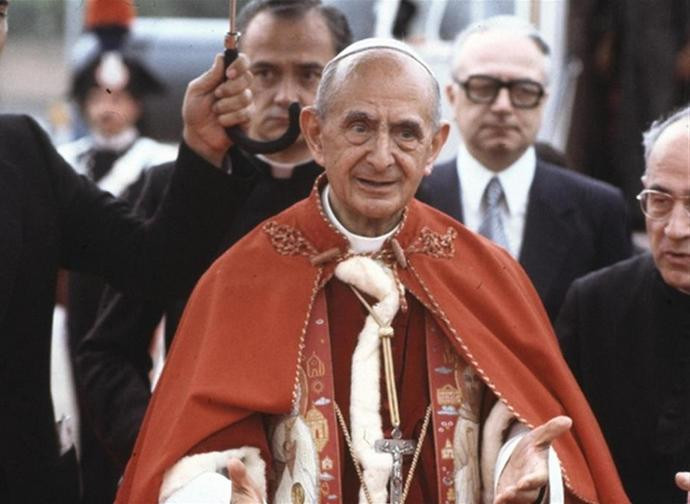Saint Paul VI
“The whole life of Paul VI was full of [...] adoration and veneration of the infinite mystery of God”, John Paul II said at the Angelus of 3 August 1980. And he added: “This is exactly how we see his figure in the light of all that he has done and taught; and we see this ever more clearly as time distances us from his earthly life and his ministry”.

“The whole life of Paul VI was full of [...] adoration and veneration of the infinite mystery of God”, John Paul II said at the Angelus of 3 August 1980. And he added: “This is exactly how we see his figure in the light of all that he has done and taught; and we see this ever more clearly as time distances us from his earthly life and his ministry”. The ministry of Saint Paul VI (1897-1978) culminated in the 15 years of his pontificate at one of the most difficult times for the Church. The Bride of Christ saw herself torn apart internally by growing modernist pressures and challenged externally by a world ever less inclined to recognise her authority in matters of faith and morals.
The second son of three brothers, Giovanni Battista Montini was born in the province of Brescia and grew up in a family of solid Catholic faith. His father, Giorgio, was engaged in the social-political field (a member of parliament, he retired after the rise of Fascism) and taught him, as the saint would recall, “never to prefer life to the reasons of life”; his mother, Giuditta Alghisi, transmitted to him “the sense of recollection, of the inner life, of meditation that is prayer”.
On 29 May 1920 he was ordained a priest and the next day he celebrated his first Mass. With a vast culture, he graduated in philosophy, canon law and civil law. For eight years, until 1933, he was national ecclesiastical assistant to the Italian Catholic University Federation (FUCI), directing students towards cultural deepening in the light of faith. Meanwhile, in 1924, his thirty-year collaboration with the Secretariat of State had begun. In these thirty years he became one of the closest collaborators of Pius XI and then of Pius XII, who, still a cardinal, had taken over the leadership of the Secretariat of State in 1930. During the Second World War, Montini worked several times to get the Church’s aid, in the name of Pope Pacelli, to the Jews.
On November 1, 1954, Pius XII appointed him archbishop of Milan. For Montini, after his long commitment to diplomacy, it was his first great pastoral experience. The Ambrosian diocese suffered from the spread of an atheistic and Marxist vision, especially in the world of work. He tried to re-evangelize it, took an interest in the conditions of the workers and started the construction of over a hundred churches.
John XXIII was another pontiff with whom he had a privileged relationship. Pope Roncalli held Montini in high esteem and at his first consistory he made him a cardinal. Montini was involved in the preparatory work for Vatican Council II. And then, when John XXIII died, his name was immediately seen as the most accredited among the papal candidates, given his reputation of moderate reformer. The Conclave elected him on 21 June 1963. Paul VI was crowned nine days later, writing a note that sounds prophetic: “Perhaps the Lord has called me and keeps me in this service not so much because I have some attitude for it, or so that I govern and save the Church from her present difficulties, but so that I suffer something for the Church, and it is clear that He, not others, guides and saves her”.
This suffering, first of all interior, reached its peak because of what followed the publication of Humanae Vitae (25 July 1968), that is, the counter-current encyclical that reiterated, at the height of the 1968 student protest movement, the Catholic vision of life and therefore of human love. Before those who pushed for the “pill”, Paul VI reaffirmed the inseparability of the unitive and procreative meaning of the conjugal act. And he foresaw the harmful consequences (the increase in marital infidelities, moral degradation, the reduction of women to mere objects of pleasure, State contraception, etc.) that the culture of contraception would produce. The encyclical, his seventh and last, attracted the wrath of the most progressive episcopal conferences. A sign of an era that attacked the virtue of obedience and, with it, the papal primacy itself.
Another challenge was the liturgical reform, which went well beyond the general indications of the Council. The new Roman Missal was born from the work of the Consilium, of which Annibale Bugnini was secretary and director. It was promulgated by Paul VI on 3 April 1969. While it is true that the Holy Father was in favour of the reform as a whole, it is also true that he did not agree with several deformations. He tried to remedy some of them, while other distortions he noticed (distracted as he was by a thousand other responsibilities) only when the work was done, with the liturgical books already printed. It seems that the famous phrase about the “smoke of Satan” that had entered “the temple of God” (29 June 1972) referred precisely to the distortions suffered by the liturgy, as confided by one of his masters of ceremonies, Monsignor Virgilio Noè.
Convinced that the Church should dialogue with the world, perhaps at times he sinned of optimism but he never conceived this dialogue as a compromise on the truth. Quite the opposite. He wrote in 1977 to Jean Guitton: “What strikes me, when I consider the Catholic world, is that within Catholicism a non-Catholic type of thought sometimes seems to predominate, and it may happen that this non-Catholic thought within Catholicism becomes the strongest tomorrow. But it will never represent the thought of the Church. A small flock must exist, however small it may be”.
He returned to the House of the Father on 6 August 1978, feast of the Transfiguration. A little more than a month earlier, on 29 June, the Solemnity of Saints Peter and Paul, while “the natural course of our life approaches sunset,” he had taken stock of his 15 years as Pope. He then recalled that his Petrine ministry was based on two pillars: the protection of the faith and the defence of human life. That is why the two miracles by which Paul VI was proclaimed saint concerned two babies (an American and an Italian, Amanda) in the womb. According to God’s will and pleasure.
Learn more:
Collection of speeches, encyclicals, letters, homilies, etc.



